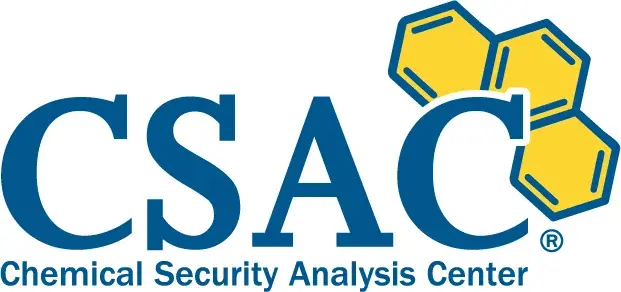 Location: Aberdeen Proving Ground, MD
Location: Aberdeen Proving Ground, MD
In 2006, by Presidential Directive, the Department of Homeland Security (DHS) established the Chemical Security Analysis Center (CSAC) to identify and assess chemical threats and vulnerabilities in the United States and develop the best responses to potential chemical hazards. Overseen by the Science and Technology Directorate (S&T), CSAC supports the homeland security community by providing a crucial knowledge repository of chemical threat information, design and execution of laboratory and field tests, and a science-based threat and risk analysis capability, among other services. CSAC’s presence on the Edgewood Area of U.S. Army Aberdeen Proving Ground, Maryland, allows close collaboration with Army scientists and engineers.
In 2022, CSAC stood up the Chemical Security Lab (CSL) as a new capability for experimental analysis of chemicals and hazardous substances to help validate scientific data and produce findings that are essential to national readiness. The CSL was established in partnership with the U.S. Army Combat Capabilities Development Command Chemical Biological Center (DEVCOM CBC). Locating CSAC’s CSL at Aberdeen Proving Ground—a Department of Defense installation—improves the laboratory’s capability and return on investment. The CSAC CSL provides unique and vital capabilities not found at any of CSAC’s sister laboratories under the S&T Office of National Laboratories. CSAC makes efficient use of the strong partnership with DEVCOM CBC to employ critical capabilities such as volatile organic compound monitoring, gas sensor array technology (e.g., electronic-nose), and imaging mass spectrometry.
For inquiries related to chemical threats and chemical hazards, CSAC offers a 24-hour, seven-days-a-week informational response capability known as “CSAC Technical Assistance” to federal, state, local, territorial, and first responder agencies. CSAC Technical Assistance is a key resource for the National Operations Center. The center typically responds to 70 to 80 requests per year and key customers include the Department of Health and Human Services, Environmental Protection Agency, Federal Bureau of Investigation and many other agencies and industry stakeholders.
CSAC applied previously developed and validated multi-zone models for chemical contamination in aircraft to understand the transmission of Severe Acute Respiratory Syndrome Coronavirus 2 (SARS-CoV-2) on commercial aircraft. These models were developed in conjunction with the United Kingdom (UK) Centre for the Protection of National Infrastructure, the UK Department for Transport, TSA, and the Irregular Warfare Technical Support Directorate, using the National Institute of Standards and Technology CONTAM software. Select potential mitigation measures such as the use of High Efficiency Particulate Air filtration, adjustment of air flow exchange rates, and universal mask wearing were evaluated for the impact on passenger exposure given a single contagious passenger and multiple contagious passengers on a flight.
Through the S&T Probabilistic Assessment of National Threats Hazards and Risks (PANTHR) program and the S&T Hazard Awareness Characterization Technology Center (HAC-TC), key parameters such as the rate of viral shedding and the particle size distribution for common activities such as breathing, talking, and coughing were estimated based on an extensive literature review. The study included estimates for the emission of both small aerosols, which are most useful for characterizing the airborne hazard and impact of filtration systems, and larger droplets, which are most important for characterizing surface contamination. The results of this study have been used to evaluate potential mitigation measures to help decrease the risk of pathogen transmission during air travel.
Each year, hundreds of millions of tons of toxic industrial chemicals (TICs) like chlorine and ammonia are transported across the United States. Significant increases in TIC production are projected due to changes in the global chemical landscape resulting from supply chain shortages and increased demand in response to the transition toward sustainable and renewable energy. Although these chemicals are essential, they are toxic and pose a risk to the public through accidental release or an act of terrorism. To better understand and address this risk, CSAC conducted Project Jack Rabbit in 2010 followed by the Jack Rabbit II Program program in 2015-2016.
Jack Rabbit I involved a series of 1- to 2-ton outdoor chlorine and ammonia release trials involving a team of stakeholders from government, industry, and academia. Jack Rabbit II continued where Jack Rabbit I left off, with release trials of up to 20 tons. These experiments were unprecedented and filled crucial knowledge and data gaps. Prior to Jack Rabbit I and II, large-scale chlorine releases had never been tested at volumes representative of rail cars, tanker trucks, barges, or bulk storage tanks. Jack Rabbit improved hazard prediction modeling, emergency planning, and response and mitigation strategies, as well as the United States' resilience against chemical release incidents.
release trials involving a team of stakeholders from government, industry, and academia. Jack Rabbit II continued where Jack Rabbit I left off, with release trials of up to 20 tons. These experiments were unprecedented and filled crucial knowledge and data gaps. Prior to Jack Rabbit I and II, large-scale chlorine releases had never been tested at volumes representative of rail cars, tanker trucks, barges, or bulk storage tanks. Jack Rabbit improved hazard prediction modeling, emergency planning, and response and mitigation strategies, as well as the United States' resilience against chemical release incidents.
Final and follow-on test reports of CSAC’s Jack Rabbit I and II programs have been approved for public release. The Jack Rabbit II Program Final Test Report documents the large-scale outdoor chlorine release trials conducted at U.S. Army Dugway Proving Ground, Utah, made possible by direct support from the U.S. Defense Threat Reduction Agency, Transport Canada (TC), and Defence Research and Development Canada (DRDC). The Chlorine Reactivity with Environmental Materials in Atmospheric Dispersion Models report describes kinetic measurements and maximum deposition effects of select vegetation exposed to toxic gas, capturing work performed in partnership and collaboration with University of Arkansas and TC/DRDC.
Jack Rabbit III was initiated to provide scientifically informed assessments for enhancing the security and resilience of the ammonia supply chain. Jack Rabbit III involves the work of a collaborative team of global partners and cosponsors from government, industry, and academia and has established technical working groups covering areas such as atmospheric dispersion modeling, source term analysis, chemical reactivity, diagnostic, human health effects, and emergency response. Scaled experiments are underway to address atmospheric dispersion modeling gaps for emergency planning and response applications. These experiments would enable higher fidelity consequence assessments, hazard prediction, and development of mitigation strategies.
In 2023, CSAC responded to a DHS National Operations Center (NOC) request for information regarding Hurricane Idalia to provide critical chemical facility information and analysis of the toxic chemical hazards and risks within the potential hurricane effect zones. Hurricanes pose a significant risk to even the most secure chemical facilities, with storm-driven power outages, high winds, and flooding potentially leading to chemical leaks, explosions, or fires. During the 2023 hurricane season, CSAC analysis documented the chemical type and the amount being stored at more than 2,000 chemical facilities in California, the Gulf Coast, eastern United States, and Puerto Rico.
Annual Reports
- CSAC FY2023 Annual Report
- CSAC FY2022 Annual Report
- CSAC FY2021 Annual Report
- CSAC FY2020 Annual Report
- CSAC FY2019 Annual Report
Fact Sheets
- Chemical Consequence and Threat Desktop Tool Fact Sheet
- Chemical Security Analysis Center (CSAC) Fact Sheet
- Chemical Security Analysis Center – Ammonia Safety and Training Institute Cooperative Research and Development Fact Sheet
- Chemical Security Analysis Center Technical Assistance Fact Sheet
- Chemical Security Laboratory (CSL) Fact Sheet
- Chemical Threat Clustering Tool Fact Sheet
- Homeland Explosive Consequence Assessment Tool (HExCAT) Fact Sheet
- Jack Rabbit II Program Fact Sheet
- Non-Traditional Agent (NTA) Library Fact Sheet
- Outdoor Chemical Dispersion Consequence Model Fact Sheet
Master Question Lists
Technical Notes
- Experimental Determination of Chemical Solubility in Water Technical Notes
- Stability Analysis of Chemicals in Food Matrices Technical Notes
Media
- Technologically Speaking Podcast: A Very Nasty Insecticide You Don't Want in Your Food
- Tech Speak Minisode Podcast: Providing the Best Information to Save Lives
- Blog: S&T National Lab Offers Chemistry-focused College Seminar
- Blog: Mentoring a New Generation of Female Scientists
- Blog: The Center of Gravity for Chemical Threats
- News Release: DHS, Army Partner to Provide New Chemical Security Laboratory Capability
- News Release: S&T Helps Keep Communities Safe from Chemical Hazards During Hurricane Season
- Feature Article: Knowledge Is Power in the Fight Against Synthetic Opioids
- Feature Article: Ensuring Coast Guard Can ‘Strike’ Fast During HAZMAT Incidents
- Feature Article: Quickly Detecting Cyanide Poisoning After Fires Can Save Lives
- Feature Article: Securing Transportation of Ammonia—Agricultural Lifeline and Future Affordable, Clean Energy Source
- Feature Article: Protecting Food from the Farm to Our Plates
- Feature Article: Journal Highlights Groundbreaking S&T Research on Chlorine Spread
- Feature Article: Preparing State and Local Leaders for an Explosive Attack
- Snapshot: Helping Law Enforcement Solve and Prevent Chemical-Related Violence
- Snapshot: Preparing for the Consequences of a Chemical Attack
We would like to hear from you! Contact us at: csacinfo@st.dhs.gov
